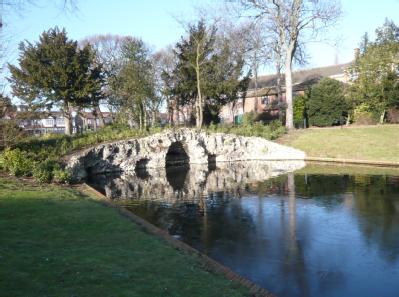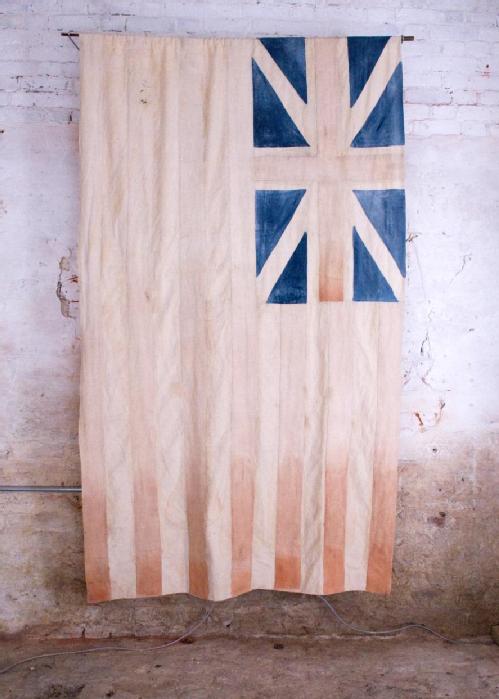Valentines Mansion from the Seventeenth to the Twenty-First Century

Valentines Mansion, its Rococo garden and wider park are a beautiful oasis in the East London suburbs. They were purchased 100 years ago (1912) by the then Ilford Urban District Council (now the London Borough of Redbridge) and were used as council offices for much of that period. From 1993 the building was left empty. Due to public pressure, and thanks to the Heritage Lottery Fund, the house and gardens both underwent major restoration in 2007-08 and are now used by the community. The final accolade was when Valentines Mansion and Gardens was the venue chosen for her Majesty the Queen to meet the people of Redbridge on 29 March 2012 as part of her Diamond Jubilee tour.
The image included here is of the Canal Grotto which features in the Rococo garden of Valentines Garden. Image courtesy of Georgina Green.
The house was originally built in 1696-7 for Mrs Elizabeth Tillotson, widow of John Tillotson, Archbishop of Canterbury. She was a lady of quality and status but not wealth, so Valentines has always been a modest family home and it appears to have provided a happy refuge for later, more affluent owners who had homes and business premises in the City.
It was in the Georgian period that the house saw its greatest luxury, in the ownership of successive men associated with the East India Company (EIC). Most prominent among these Company men was Sir Charles Raymond (1713-88) who became wealthy through the EIC's lucrative trade in India and China. Thanks to family connections, Raymond rose rapidly through the ranks and served as captain on four of the six voyages he made, all to India. He was able to make a small fortune through his legitimate private trade so that when he retired from the sea at the age of 34 he turned to managing voyages for the EIC. Raymond was never involved as a Director of the EIC but was a Manager of the Sun Fire Office from 1756 until 1773 and in 1766 he was elected a Director of the South Sea Company. His charity work included being a Governor of Bridewell and Bethlem Hospitals. He dabbled in politics and became a greatly respected banker before being created a baronet in 1774.
The last private resident of Valentines, or Valentine House (the council gave it the title of Mansion) was Sarah Ingleby, widow of Dr Clement M Ingleby, a noted Shakespearian scholar and writer, who lived most of her life here. Her generous community involvement provides a wonderful example of Victorian philanthropy for the school children who now visit the building which was her home. She died in 1906 and her son sold the house and grounds to the council in 1912.
In the early 1990s, after many years as council offices, the building was vacated and there was considerable discussion about the most suitable future use. Eventually, late in 1999 it was decided to set up a charity, the Valentines Mansion Trust, which would lease the building from the council at a peppercorn rent and run it for the community. However, a major restoration was necessary so the Trust drew up a business plan and other documentation to apply for Heritage Lottery Funding. This application was unsuccessful. The council took back responsbility, and they were eventually granted lottery funding. In order to support their application the Trust had set up the 'Friends of Valentines Mansion' . The public support they demonstrated was a significant factor in the lottery award.
. The public support they demonstrated was a significant factor in the lottery award.
In order to raise public interest, and assist the Heritage Lottery Fund application, existing knowledge of the history of Valentines was revisited and more research carried out by Georgina Green, the author of the present case study, on Valentines and its EIC context. Georgina was born and brought up in Chingford, on the edge of East London and has been involved in local history in Waltham Forest and Redbridge since the early 1980s. She was asked to be a Trustee of Valentines Mansion and was also instrumental in the creation of The Friends. Her role was to research the history of the Mansion and its owners, to write and lecture, and it increase public awareness of the importance of the building.

There was already a bank of knowledge about the owners but Georgina tried to dig deeper and add to this. Starting before computers made research easier, she followed up a comment that Sir Charles Raymond may have been connected with the EIC. While at the Guildhall Library in London she came across two books by Anthony Farrington (both published by the British Library in 1999) which were key to opening the door on this aspect of her research.
A Biographical Index of East India Company Maritime Service Officers 1600-1834 gave details of Raymond's rapid rise through the Company, showing the ships he had sailed in and positions he held. The Catalogue of East India Company Ships' Journals and Logs 1660-1834 listed the ships managed by Raymond, and gave details of the voyages of every ship which had sailed for the EIC.
The above image shows Valentines Mansion as it stands today after its 2007-08 refurbishment. Image courtesy of Georgina Green.
When she realised the value of these two books Georgina acquired her own copies and they have been invaluable in tracing the links between Sir Charles Raymond, some of his relatives, fellow captains and other business associates who lived in East London. Jean Sutton's Lords of the East: The East India Company and its Ships 1600-1874 (Conway Maritime Press, 1981, new edition 2000) also provided an understanding of how ships were staffed and managed.
Before long Georgina was consulting the EIC Court Books and reading the journals written by Raymond and other captains on their voyages to India and the East, held at the British Library. She was enthralled by the idea that the captain's journal in front of her had been written in his cabin, while at sea, 275 or so years ago. Georgina became fascinated by the experiences recorded and the adventures of some of the personnel who came to live in Ilford and nearby areas when they retired from the sea. Her 'day job' gave Georgina the expertise to compile a spreadsheet of these voyages and add in details of owners and various officers, with her own notes, which enabled her to explore the links that Captain Charles Raymond managed.
Georgina's background as a local historian, without prior knowledge of the EIC, meant she was eager to explore every aspect of the subject and her first visit to the National Maritime Museum gave her much food for thought. Now with ten years of experience looking at the EIC archives, Georgina is still amazed and delighted as she discovers new sources of information. It has been suggested that the EIC archives are too extensive to ever be fully explored by one person, but the staff are very helpful and half the fun is in trying! The connection with the EIC was a new aspect of Valentines' history revealed around 2001 by Georgina. Her research on this subject is continuing at the British Library and Georgina plays an active role as Project Associate on The East India Company at Home project.
 Georgina's research and subsequent lectures and displays encouraged two local artists, Margaret Duston and Kathy Taylor, to create an installation based on the wreck of the Valentine (for information on the wreck go to the 'Shipwrecks and the EIC's 'Immaterial' Material Culture' section of the case study). This was displayed in the old restored dovecote in the Valentines Gardens in May 2010 and created considerable interest.
Georgina's research and subsequent lectures and displays encouraged two local artists, Margaret Duston and Kathy Taylor, to create an installation based on the wreck of the Valentine (for information on the wreck go to the 'Shipwrecks and the EIC's 'Immaterial' Material Culture' section of the case study). This was displayed in the old restored dovecote in the Valentines Gardens in May 2010 and created considerable interest.
Inspired by Valentines Mansion and some of the research completed by Georgina Green, local artist Kathy Taylor created the response shown right.
Stain by Kathy Taylor
Indian cotton, stained with tea, indigo and dye extracted from red dyewood/red sanders dust from the Valentine cargo
The flag design is based on the British East India Company Flag of 1707-1801
To read the next section of the case study - Valentines' EIC Owners and Their Material Objects - click here.
To read to the Main Menu, click here.
